The 3-door Bravo has large rear 'haunches',an almost vertical tailgate and large, round light clusters which give a more 'agressive'
or sporting appearance. On the other hand, the 5-door Brava has an extra pair of doors, a
more sloping rear window, a slight 'notch' back, hinting at a boot, and a very distinct light
arrangement with three horizontal strips on each side. Detail differences between the two included different wheeltrims, various external trim being
body-coloured on one and not the other, different instrument clusters inside and differing upholstery and trims. The similarities of the body designs
resulted in predictably similar drag coefficients, these being 0.32 and 0.33 for the Bravo and Brava respectively.
The Bravo/Brava was a mechanically conventional design, with a front mounted transverse engine driving the front wheels.
MacPherson strut front suspension, with an anti-roll bar, was joined by an independent rear setup using tailing arms. Braking was by a dual-circuit system with
discs at the front and drums at the rear, except on the top of the range HGT (2.0 20V 5 cylinder)
which also has discs at the rear. ABS (by ITT TEVES) was standard or optional depending on trim level, engine and market. Unlike the Tipo, power steering
was standard on all cars.
In terms of powerplants, the Bravo/Brava launched with 1370cc (12V with 80bhp),
1581cc (16V with 103bhp), 1747cc (16V with 113bhp) four cylinder petrol engines and a 1998cc (20V with 147bhp only in the Bravo) five cylinder
Safety was becoming more important as the Bravo/Brava were developed, and the cars came with a driver's and passengers' airbags (standard or optional
depending on the market - some also offered side airbags), height adjustable seatbelts with pretensioners, a fire protection system and a structure designed with crumple zones, anti-intrusion
bars, special reinforcements in critical locations, a collapsible steering column, anti-submarining seats and more.
Internally the new cars featured a completely new, ergonomically optimised, dashboard and layout. Very distinctive, the dashboard featured a large central
teardrop console with the audio system and ventilation controls, and a single instrument cluster in front of the driver. Apart from entry level versions a rev-counter
was present in all cars. The seats featured the latest orthopaedic design, the drivers' being height adjustable. The rear seat could be folded down
to provide additional luggage capacity.
The Bravo/Brava was replaced in 2001 by the all new Stilo. The replacement for the latter
saw the Bravo name used again in 2007.
See our 'Concept
Cars' page for the FLAIR aerodynamic concept car based on the Bravo and also the Zagato designed Bravo Coupé.
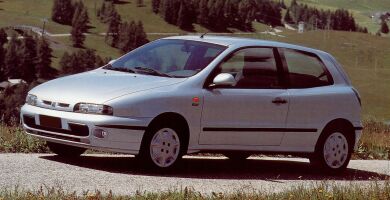 First shown in 1995, the new pair of medium class cars, the Bravo/Brava, were
awarded Car of the Year in 1996. Designed in-house at the Centro Stile
Fiat, the Bravo and Brava replaced the Tipo with
two bodystyles, the Bravo with three doors and the Brava with five.
Both cars share the same mechanicals, and are identical as far back as
the A-pillar (apart from slightly different front grilles) after which the bodyshells are completely different.
First shown in 1995, the new pair of medium class cars, the Bravo/Brava, were
awarded Car of the Year in 1996. Designed in-house at the Centro Stile
Fiat, the Bravo and Brava replaced the Tipo with
two bodystyles, the Bravo with three doors and the Brava with five.
Both cars share the same mechanicals, and are identical as far back as
the A-pillar (apart from slightly different front grilles) after which the bodyshells are completely different.
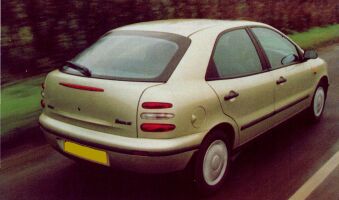 On the same floorpan, and again sharing the front end are also built the Marea,
a four-door saloon, and the Marea Weekend, an estate variant of the same car.
On the same floorpan, and again sharing the front end are also built the Marea,
a four-door saloon, and the Marea Weekend, an estate variant of the same car.
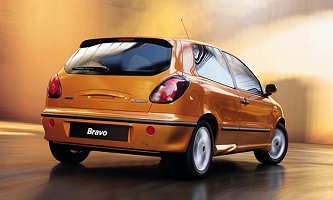 petrol engine. A normally aspirated 1929cc diesel with 65bhp was joined by two 1910cc turbocharged
four cylinder, indirect injection units, one with 75bhp and the other with 100bhp. Transmissions were all five-speed manual except an optional four-speed
automatic available with the 1600 engine.
petrol engine. A normally aspirated 1929cc diesel with 65bhp was joined by two 1910cc turbocharged
four cylinder, indirect injection units, one with 75bhp and the other with 100bhp. Transmissions were all five-speed manual except an optional four-speed
automatic available with the 1600 engine.
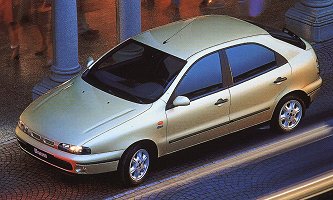 1999 saw a mild facelift, both inside and out, with details such as new wheel trims, new colours, new grilles and a variety of small engineering changes. Most significant
were the replacement of the 12V 1370cc unit with a 16V 1242cc (82bhp) item,
the increase of power from the 1998cc 20V engine, up to 154bhp, and a new common rail diesel unit, the 1.9 JTD (105bhp). This latter used the (then) very
advanced Unijet fuel injection system.
1999 saw a mild facelift, both inside and out, with details such as new wheel trims, new colours, new grilles and a variety of small engineering changes. Most significant
were the replacement of the 12V 1370cc unit with a 16V 1242cc (82bhp) item,
the increase of power from the 1998cc 20V engine, up to 154bhp, and a new common rail diesel unit, the 1.9 JTD (105bhp). This latter used the (then) very
advanced Unijet fuel injection system.
Technical Details
| Driveline | transverse engine at front with front wheel drive |
| Engines | 1242cc (70.8x78.9mm) dohc 16v 4 cylinder with 82bhp @ 5,500rpm (image)
1370cc 12v 4 cylinder with 80bhp @ 6,000rpm 1581cc (86.4x67.4mm) dohc 16v 4 cylinder with 103bhp @ 5,750rpm 1747cc (82x82.7mm) dohc 16v 4 cylinder with 113bhp @ 5,800rpm (image) 1998cc (82x75.7mm) dohc 20v 5 cylinder with 154bhp @ 6,500rpm (earlier 147bhp @ 6,100rpm) (image) 1910cc (82x90.4mm) sohc 8v 4 cylinder turbo diesel with 75bhp or 100bhp @ 4,200rpm (image) 1929cc (82.6x90mm) sohc 8v diesel with 65bhp @ 4,600rpm later the 1910cc diesel became available as in JTD form, with direct injection and 105bhp @ 4,000rpm (image) |
| Suspension | front : MacPherson strut with telescopic dampers and coil springs plus anti-roll bar
rear : independent with telescopic dampers within coil springs plus anti-roll bar wheelbase : 2540mm front track : 1439 to 1471mm (depending on version) rear track : 1430 to 1453mm (depending on version) |
| Brakes | front : discs, diameter 257mm
except 'HGT': 284mm ventilated discs rear : drums, diameter 203mm except '80' (no ABS): 180mm drum, 'HGT' : 240mm solid discs handbrake operating on the rear via a cable |
| Gearbox | 5 speed manual
4 speed automatic |
| Steering | rack and pinion
power assisted 3 turns lock to lock |
| Kerb Weight | Brava : JTD105 : 1195kg |
| Dimensions | Bravo, Brava |
There are cutaway pictures of the Bravo and
Brava.
There are also cutaway drawings showing the safety features of the
Bravo and
Brava.
 |
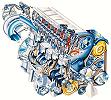 |
 |
 |
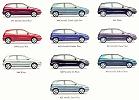 |
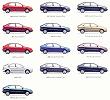 |
Performance
| model | max speed | 0-100kph/0-60mph | in gear acceleration |
| HGT (147bhp version) | 130 mph | 8.1 sec | 9.2 (50-70 in 5th) |
| 1.6 SX | 113 mph | 10 sec | 14.7 (50-70 in 5th) |
Tuning
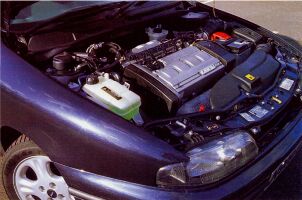 There are three main areas to concentrate
on, the engine (and transmission), the brakes and the suspension and then
various other details. These three should be done together since they complement
each other, not all of one and none of another !
There are three main areas to concentrate
on, the engine (and transmission), the brakes and the suspension and then
various other details. These three should be done together since they complement
each other, not all of one and none of another !
1. The engine.
Before modifying the engine it is worthwhile filling it with a good quality synthetic oil and fitting new spark plugs. An engine oil additive may also be used.
The first improvements are relatively simple.
The air filter can be replaced for an aftermarket item which will help
the engine breathe more freely, the type which completely replace the original airbox are best,
and the exhaust can be replaced for one which will restrict the exit of
the gases less. The whole system should be replaced, not just the back
box. Stainless steel will last longer, but normal steel with a good coat
of heat resistant paint will last a good while.
Other things to do should include fitting
a cold air intake, a large diameter pipe (minimum 5cm) to provide air from
outside the engine bay to the air filter. The exhaust manifold can also
be lagged with thermal cloth or tape to keep the exhaust gases hotter (and
thus reduce back pressure) and also to keep the underbonnet (and hence
intake and fuel) temperatures lower.
Further modifications require the machining
of the cylinder headand/or cylinder block (which will not be dealt with
here since it is not normally a DIY job) after which it may be worth fitting
an oil cooler. If overheating is a problem due to the increased power output
then a small hole can also be drilled through the plate in the thermostat.
Regarding the transmission the main requirement
is to uprate the clutch to handle the increase in power and torque achieved
though the engine modifications. Friction plates can be purchased with
improved materials and heavier duty pressure plates are also available.
Whilst doing this it is worthwhile lightening the flywheel.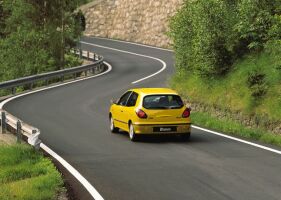 The most effective modification (short of engine rebuilds!) is probably to replace the electronic control unit
(or 'chip'). A variety of these are available, but all should increase
the power and improve the driveability. The downside is that these usually
cancel the warranty and may affect the durability of the engine, the emissions
and the fuel consumption. If one is not available for your specific model
it is possible to buy a general one for any car and programme it.
The most effective modification (short of engine rebuilds!) is probably to replace the electronic control unit
(or 'chip'). A variety of these are available, but all should increase
the power and improve the driveability. The downside is that these usually
cancel the warranty and may affect the durability of the engine, the emissions
and the fuel consumption. If one is not available for your specific model
it is possible to buy a general one for any car and programme it.
The high tension leads can also be replaced with performance ones.
2. The brakes.
If more serious braking is required the
next modification would be to increase the disc size. It is possible to
use larger discs with a bracket allowing use of the production callipers,
or alloy four pot callipers can be fitted. On lower models it is possible
to fit HGT brakes which will provide more stopping power.
In order to improve the balance of the
car under braking it is desireable to be able to adjust the balance of
braking from front to rear (and vice versa). This can be accomplished by
fitting a bias valve in the line to the rear brakes, usually in a position
so that it can be reached from the drivers seat.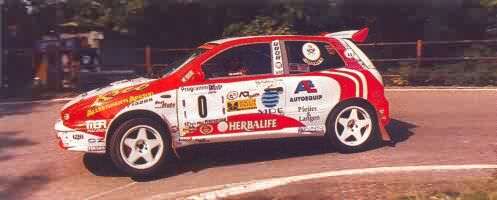 Initially it is relatively easy to replace
the brake discs with drilled and grooved items, and the pads for a harder
compound. The latter should not be too hard (ie no race pads on the road) or they will not function
effectively at the normal 'road' operating temperatures. Stainless steel
braided flexible hoses will improve the pedal feel and reduce the chance
of damage whilst DoT5 fluid (not silicon) will increase the temperature
at which it can operate effectively. If the brakes are getting too hot
the dustguards can be removed and/or ducts fitted, taking air from behind
the front bumper.
Initially it is relatively easy to replace
the brake discs with drilled and grooved items, and the pads for a harder
compound. The latter should not be too hard (ie no race pads on the road) or they will not function
effectively at the normal 'road' operating temperatures. Stainless steel
braided flexible hoses will improve the pedal feel and reduce the chance
of damage whilst DoT5 fluid (not silicon) will increase the temperature
at which it can operate effectively. If the brakes are getting too hot
the dustguards can be removed and/or ducts fitted, taking air from behind
the front bumper.
3. The suspension.
The easiest improvement,and the one which
will probably bring the single most noticeable change, is to replace the
full set of dampers and springs. A variety of kits are available which
include four matched dampers and springs. Top adjustable units are compromised,
but are good for road and track day cars since it allows the suspension
to be adjusted between these two, rather different, requirements. Coil
over units add more adjustability and can be purchased outright, or can
be made from standard dampers by welding a threaded sleeve to the standard tube.
Into this category also fall the choice
of wheels and tyres. With an increase in power it can be necessary to fit
larger tyres (thus requiring larger wheels) but the temptation to fit the
biggest possible should be resisted. Consideration should be given to fitting
a wider tyre on the front (since they provide traction and steering) but
keeping the standard, or a wider but not as wide as the front, tyre at
the rear. This will improve the balance of the car.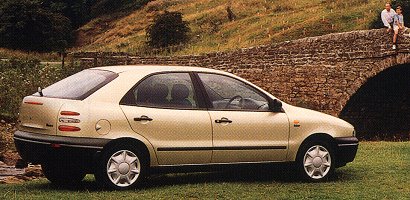 There are then the other main suspension
aims; to reduce the flexiblity in the suspension and to increase the stiffness
of the car, both of which aim at more accurate control of the wheel movement. To reduce
the flexibility it is possible to fit nylon bushes instead of the normal
production rubber items, or if perfection is desired the suspension can
be fitted with metallic bearings (rose joints / rod ends). Spherical bearing
top mounts can also be used. To stiffen the car it is most popular to fit
strut braces. These can be fitted to the front and rear. For more extreme
cases a rollcage can be fitted.....
There are then the other main suspension
aims; to reduce the flexiblity in the suspension and to increase the stiffness
of the car, both of which aim at more accurate control of the wheel movement. To reduce
the flexibility it is possible to fit nylon bushes instead of the normal
production rubber items, or if perfection is desired the suspension can
be fitted with metallic bearings (rose joints / rod ends). Spherical bearing
top mounts can also be used. To stiffen the car it is most popular to fit
strut braces. These can be fitted to the front and rear. For more extreme
cases a rollcage can be fitted.....
4. other things.
Other modifications worth considering include fitment of a shift light (and rev limiter if there is not one as standard), higher power bulbs in the headlights (if you are going to go faster you need to see further) and installation of a quicker steering rack.
Buying / Selling
Tidy inside the car thoroughly : hoover the floor, empty all pockets, ashtrays (wash), glove compartment etc...,
wipe the trim with a damp cloth, give the cockpit a good airing to get rid of any odours ! Reset
the trip meter to 00000 - it is a pleasant (subconcious) surprise.
If the car has been standing give it a good run - this will clear out the engine (reduce exhaust smoke), put a
shine on the brake discs and loosen up any joints that may otherwise make some noises.
'Back to black' products are very effective
at temporarily restoring bumpers and trim. This makes a big difference
to any car. Do it a week before you expect people to view the car, otherwise it may be a bit too obvious !
Jetwash under the car, especially under
the engine and in the wheelarches. The prospective buyer may be an enthusiast,
and this makes it easier for them to see what they want to check.
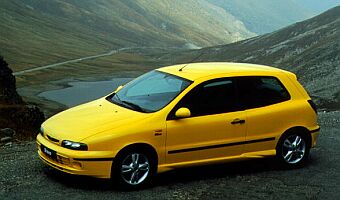 Some tips to do before selling :
(they may seem obvious, but most people don't do them and thus are in a weaker bargaining position).
Some tips to do before selling :
(they may seem obvious, but most people don't do them and thus are in a weaker bargaining position).
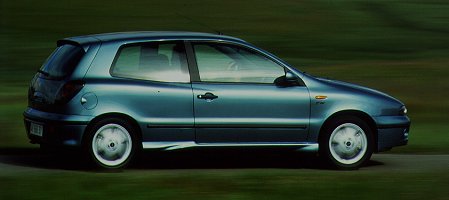 Obviously wash the car and clean the windows !
Obviously wash the car and clean the windows !
If you are going to buy a car always check the following :
Firstly check the bodywork. Check that
there are no mismatching panels, large areas of discolouration or signs
of fresh paint (compare inside the engine bay with the external body colour),
all of which probably indicate accident damage.
Check the main electrical functions - wipers,
windows, lights, etc... try putting the main beam and wipers on at the
same time. Check the headlights for cracks.
Check the brake pedal does not go to the
floor if pressed hard for a long time and check the gearchange for clean engagement.
The engine should be run up to temperature, check the exhaust for smoke, the
condition of the breather (look for mayonnaise), the condition of the oil
filler cap (again white deposits can indicate head gasket or other serious
problems or the use of the car only on short journeys, another bad state
of affairs) and the colour of the coolant (preferably not thick or dark
Check tyre wear, uneven patterns could imply a bent chassis.
Always take it for a test drive. Check
that the car tracks in a straight line with no steering input and also
remains straight under braking. Find a large open area and complete several
lock to lock turns (also in reverse), listening for any noises. Try the
handbrake when moving - seized rear callipers will mean uneven braking or no braking.
On the Bravo/a you should also check the
cassette unit (the lids break) and the air conditioning (if fitted) for
correct operation.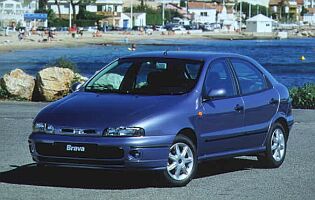 brown!). Listen to the noise of the engine, then depress the clutch and
engage first gear. Whatever noise has disappeared was coming form the gearbox,
what remains is from the engine. Also check the condition of the engine
oil on the dipstick.The lighter brown the better, if it is thick black
then leave quickly.
brown!). Listen to the noise of the engine, then depress the clutch and
engage first gear. Whatever noise has disappeared was coming form the gearbox,
what remains is from the engine. Also check the condition of the engine
oil on the dipstick.The lighter brown the better, if it is thick black
then leave quickly.
Fiat Bravo/Brava Workshop Manual :
buy
it online here (in association with
Amazon)
| Fiat Bravo & Brava 1995 to 2000 | Haynes, 2000 |
For more books on Fiats, see our Online Bookstore
Links
The Bravo/Brava/Marea Owners Club website
There is also a list of all our picture galleries (including museums, motorshows and various events).
Wallpapers/Desktop Backgrounds of numerous Fiats also available to download.
Bravo/Brava comment form
Your Comments
I'm a Costarican happy Brava
owner. It is my second car because my first was a Uno but the family grew
up so I decided to change to Brava. With both of them, I really enjoyn
driving and always is a new experience. (Carlos)
I have had a 1.6 Brava for
5 years now- . Great car- lots of poke- and room. Very well finished. Badly
designes interior pockets and shelfs. (Zebra, Ireland)
I'm a happy owner of FIAT
BRAVA 1.6 EL year 1996; great design, comfort, driving pleasure, engine
and everything. Indeed it's still a car that distinguish itself among all
those grey GOLFs clogging the Italian roads! Congrats on this site! (Riccardo, Italy)
Bravo is a dream.... Come true! (Barramas, Hungary)
I bought a brand new silver Brava 80 SX 16V in September 2000. What a beautiful car, best car I have
owned, not a single peoblem, even my two teenage sons think it is cool to go out for a drive in it. (Barry, UK)
I'm an happy Bravo 1.4 sx owner since 1996. The car is fantastic no problem in five years. Nevertheless Alfa 147, Audi A3, Peugeot 307, Fiat stilo,
VW Golf I think that Bravo is the most beutiful three door car. (Giuseppe, Italy)
I like the Brava - they're excellent car's and I'm currently working on a styling project for it. Beware the snapping cam belts -
take your car to fiat to ensure that yours doesn't need the modified tensioner. (Anthony, UK)
Greetings from Buenos Aires, Argentina. I own a 155 HGT. Good performances, really fast, better stability at high speed, very comfortable interior.
225 kmh on highways is like riding on the wind!! You have to try one 155. What else can I say?!??!!??!!
I own a Brava from new since 4 years now and I am still very happy with it.
The chairs are great and the room for your knees is still unmatched by any other car, thanks to the "organic" dashboard. Why doesn't Fiat use this anymore by the way. (Paul M, Netherlands)
One of the most beautiful cars i have ever seen.Driving it is a pleasure comparable only with flying on your own wings.(Mot, Poland)
I have owned a Brava 1.4 SX since 1996 and I really enjoy driving
it, the styling is excellent. Although I have had some problems, it is still
a great car. One word of warning though, beware the cam belt tensioner. I
had mine shatter whilst just cresting a steep hill (lucky or what), and
although I was out of my warrenty period Fiat UK stood for the cost of
rebuilding the engine. Renewing my faith in them. (K.R, UK)
I own an HGT, its a great car, its fast and really stable at high speeds, much better than my fathers Stilo. The breaks are even better than the engine. The 155 hp engine gives
its a good performance considering the wheigth and that it is a production car. Last week a guy try to race me with a brand new 2.0 Focus and he couldn t belive what my 200.000kms
car made to his... (Sebastian, Argentina)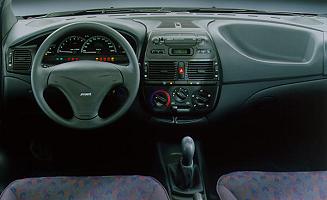 I'm Giuseppe from the Netherlands and own a Bravo 1.6 SX with alloy wheels (15") and lowered suspension.
I bought it as a new car and drove it around for 80.000 kilometers. No
problems detected so far. It's a real good car wich you can thrust. I still
love to drive the car. It is fast and is stable around the corners. However
I'm gone sell the car because of a growing family. I now want to buy a
Marea sedan. To bad, because if the family would not grow this fast, I
would have kept my Bravo. IT IS A BEAUTY!!!!!
I'm Giuseppe from the Netherlands and own a Bravo 1.6 SX with alloy wheels (15") and lowered suspension.
I bought it as a new car and drove it around for 80.000 kilometers. No
problems detected so far. It's a real good car wich you can thrust. I still
love to drive the car. It is fast and is stable around the corners. However
I'm gone sell the car because of a growing family. I now want to buy a
Marea sedan. To bad, because if the family would not grow this fast, I
would have kept my Bravo. IT IS A BEAUTY!!!!!
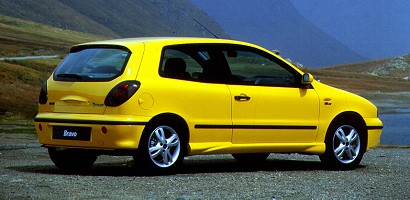
Use the buttons at the top to navigate further, or
Copyright © 2000 to 2008 CarsfromItaly